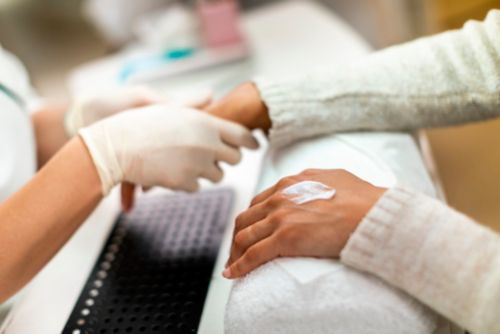Menu
Close
Back
Welcome to
Together is a new resource for anyone affected by pediatric cancer - patients and their parents, family members, and friends.
Learn MoreSome treatments are painful, like getting a needlestick (venipuncture), starting an IV, or putting a needle in a port. Your care team can help your child feel less pain. They may numb your child's skin before treatment with a medicine called lidocaine. The medicine in the cream only goes into the skin's top layer. Your child will feel pressure from the needle going through the skin, but the needlestick will not feel painful.
Your child might get lidocaine cream before getting shots (injections). For shots, they might feel pain or irritation from the medicine but not feel pain from the needlestick.
You can put lidocaine cream on your child's skin. Lidocaine cream works best when you put it on your child’s skin 30 to 60 minutes before the treatment or procedure.
Gather these supplies:
Follow these steps:

Apply lidocaine cream as directed. Use a gloved hand and cover the cream with a bandage.
Your child needs a protective bandage to keep the cream in place. Follow these steps to apply the bandage.
If your child gets an IV, your nurse may ask you to apply the cream in 2 places on the skin. Use half of the tube on each place.
Wash your hands with soap and water when you finish.
Once the cream is on your child's skin, you need to:
The nurse will remove the bandage and cream before treatment and clean your child's skin.
Helpful tips:
Lidocaine cream could numb your child's skin as long as 90 minutes after it is removed. Your child might not feel anything in that area. They might scratch, rub, or touch very hot or cold objects in that area. Watch that they do not hurt themselves before the numbness wears off.
Keep all lidocaine cream out of reach of children. If you use only half of the tube, you may save the rest for the next time your child needs it. Remember:
Do not use lidocaine cream:
All medicines have side effects. Some lidocaine side effects are mild, and you do not need to tell your child's doctor about them. These include:
Tell your child's doctor right away if your child has any of these side effects:
Remove lidocaine cream from your child's skin if they have any of these side effects. Call their doctor or nurse.
If your child has breathing problems or seizures, call 911 or emergency services. Take the lidocaine cream off their skin.
Read helpful information about needlesticks and other ways to manage pain:
If you have questions or concerns about lidocaine cream, please talk to your child's doctor or nurse.
—
Reviewed: September 2022